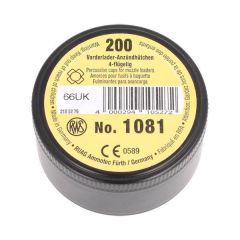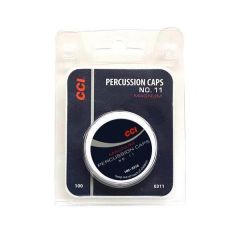We use cookies to make your experience better. To comply with the new e-Privacy directive, we need to ask for your consent to set the cookies. Learn more
How To Select The Right Percussion Cap For Your Muzzle Loading Gun
Fortunately, unlike many things muzzle loading, selecting the right percussion cap is a fairly painless process.
Since it's invention in around 1820, the percussion cap has remained pretty much unchanged. There are various sizes for different guns, but fortunately, these sizes have historically been rather similar, and a percussion cap made today will still fit a gun of the early 19th century. In the heyday of muzzle loading guns, percussion caps were made by countless manufacturers, but the design of nipple changed very little and sizes are consistent with today.
In older parlance, you may see percussion caps referred to as blasting caps, nitro caps, revolving pistol caps or similar, and you may also see early references to primers as percussion caps. To avoid any confusion therefore, percussion caps today refer to the small brass cups containing a fulminate of mercury to be applied to the nipple of a percussion muzzle loading gun.
The three main sizes of percussion cap you will encounter will be No.10, No.11, or musket caps.
Percussion cap size comparison chart
| Cap | Inside diameter | Height | Internal Height | Number in a pack |
| CCI No.10 | .161 | .163 | .112 | 100 |
| CCI No.11 | .166 | .165 | .113 | 100 |
| CCI No.11 Magnum | .166 | .165 | .113 | 100 |
| Remington No.10 | .166 | .181 | .144 | 100 |
| Remington No.11 | .166 | .152 | .115 | 100 |
| RWS 1075 No.11 | .165 | .160 | .114 | 250 |
| RWS 1055 No.11 | .158 | .200 | .112 | 250 |
| RWS 4 Wing Musket | .230 | .227 | .187 | 200 |
Click here to see all these percussion caps available on our website
The importance of proper fitting percussion caps
Many shooters will decry that any roughly sized percussion cap will work. In some guns, proper fitting percussion caps are more important than on others, but for proper, consistent detonation and shooting, a proper sized cap should be used wherever possible.
A properly sized percussion cap will seat firmly on the nipple, with the priming compound resting on the top of the nipple opening. Too small a cap will not seat sufficiently far down the nipple, and the first strike from the hammer will more than likely misfire, as the first blow will push the cap further on to the nipple, possibly splitting the side in the process.
The cap should fire on the second strike, but this is generally not good practise and split caps will lead to further unreliability. Too large a nipple may simply fall off. This can be obviated somewhat by pinching the sides of the cap, to give a tighter fit, though with this method, gas escapes around the side of the cap, likewise causing the possibility of a misfire.

Percussion caps and black powder revolvers
Revolvers are the most picky when it comes to percussion caps. All the previous reasons remain the same for revolvers, however unlike single shot guns, the cylinder must advance for the next shot to be presented for firing.
Percussion caps are the main cause of firing or jamming issues with revolvers. Caps that are too long can jam the action, as the cylinder cannot advance as it is prevented by a percussion cap sticking proud and fouling the frame as the cylinder rotates. Broken shards of cap can also clog the action and require a full disassembly to clear the problem.
A tight fitting, suitable cap will allow the gun to function during firing, and also direct the force of the blast in one direction; into the nipple. If a cap is used that does not properly fit, the cap can detonate erratically, causing shards of cap to find its way into the action of the gun. Open frame Colts are rather subject to this problem, with Remington 1858s less so, though it does still occur.
How to select the right percussion cap for your gun
Firstly the shooter must measure the nipple for which the cap is required, by it's diameter at the point where the priming compound will touch the top of the cap; in other words, the internal diameter. Therefore, to measure a nipple for a CCI No.10 cap, measure the diameter of the nipple .112 down the cone.
Ideally, a proper fitting cap will contact the top of the cap, and fit snugly in place, so the diameter of the nipple should be the exact size of the ID of the cap, or a few thousandths of an inch smaller, so the cap can be pushed firmly into place. The main consideration is the internal height of the nipple. As nipples invariably taper towards the base, a slightly wider cap may be used and pushed further onto the nipple. The conical part of a nipple is turned on a lathe, and as a result has minute machining marks that can aid cap retention.
Practical considerations
The problem in correct nipple fit lies in the lack of standardisation on either side. Percussion caps are broadly similar in size, but there is no official standard. The same is true of nipples, they vary between manufacturer and between gun. Practically speaking, trial and error can be the best way of finding the correct percussion cap for your gun.
At the range, people use different kinds of percussion cap depending on gun and preference, and few shooters would begrudge you a handful. To ensure consistency, once you find a percussion cap that works for you, stick with it. Even though they all do the same thing, the construction and composition can vary, so I would therefore not expect in the same gun, half a cylinder loaded with one type of cap, and the other half with another type of cap, to have the same point of aim. There is no exact science to it, measuring your nipples can give you a good idea of fit, but trying them is ultimately the best way.

Fortunately, percussion caps are cheap and plentiful, and fellow shooters are always only too happy to share their advice, so with these things in mind, hopefully you'll find choosing the right percussion cap a fairly simple process.
Percussion caps are available mail order from our website, and we do our best to stock a comprehensive range for every situation. Click here to see our full range of percussion caps.









